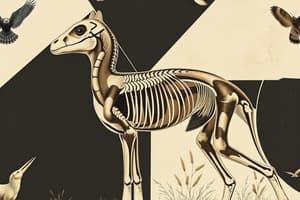Podcast
Questions and Answers
Which of the following is NOT a group of vertebrates?
Which of the following is NOT a group of vertebrates?
- Amphibians
- Insects (correct)
- Mammals
- Birds
All vertebrates lay eggs.
All vertebrates lay eggs.
False (B)
Name one group of vertebrates.
Name one group of vertebrates.
fish
The five groups of vertebrates are fish, amphibians, reptiles, birds, and __________.
The five groups of vertebrates are fish, amphibians, reptiles, birds, and __________.
Match the following vertebrate groups with their characteristics:
Match the following vertebrate groups with their characteristics:
What is the primary basis for classifying animals into vertebrates and invertebrates?
What is the primary basis for classifying animals into vertebrates and invertebrates?
All animals are classified as vertebrates.
All animals are classified as vertebrates.
What are the two main classifications of animals?
What are the two main classifications of animals?
Animals without a backbone are called __________.
Animals without a backbone are called __________.
Match the following classifications with their definitions:
Match the following classifications with their definitions:
Which type of seed plants produces flowers?
Which type of seed plants produces flowers?
Non-flowering plants are characterized by their ability to produce flowers.
Non-flowering plants are characterized by their ability to produce flowers.
Name the two groups seed plants can be classified into.
Name the two groups seed plants can be classified into.
Seed plants that do not produce flowers are called __________.
Seed plants that do not produce flowers are called __________.
Match the following terms with their definitions:
Match the following terms with their definitions:
Which of the following statements is true regarding vascular plants?
Which of the following statements is true regarding vascular plants?
Non-vascular plants have specialized tissues for the transport of water and nutrients.
Non-vascular plants have specialized tissues for the transport of water and nutrients.
What are the two main categories of plant classification?
What are the two main categories of plant classification?
Vascular plants are characterized by the presence of ______ tissues.
Vascular plants are characterized by the presence of ______ tissues.
Match the following categories of plants with their characteristics:
Match the following categories of plants with their characteristics:
What is one key distinction between vascular plants?
What is one key distinction between vascular plants?
All vascular plants produce seeds.
All vascular plants produce seeds.
Name the two classifications of vascular plants.
Name the two classifications of vascular plants.
Vascular plants are primarily categorized into _____ plants and _____ plants.
Vascular plants are primarily categorized into _____ plants and _____ plants.
Match the following categories with their characteristics:
Match the following categories with their characteristics:
What term describes the special body features that help living things survive in their habitats?
What term describes the special body features that help living things survive in their habitats?
The term 'habitat' refers to the specific features of a living organism's body.
The term 'habitat' refers to the specific features of a living organism's body.
What is the primary function of adaptation in living organisms?
What is the primary function of adaptation in living organisms?
Adaptation helps living things perform better in their ______.
Adaptation helps living things perform better in their ______.
Match the following terms with their definitions:
Match the following terms with their definitions:
Which of the following is a characteristic of mammals?
Which of the following is a characteristic of mammals?
All vertebrates are warm-blooded.
All vertebrates are warm-blooded.
Which of the following is NOT a characteristic of fish?
Which of the following is NOT a characteristic of fish?
Name one group of vertebrates that lays eggs in water.
Name one group of vertebrates that lays eggs in water.
Amphibians can breathe underwater but do not breathe on land.
Amphibians can breathe underwater but do not breathe on land.
Reproduction is essential for the continued survival of __________.
Reproduction is essential for the continued survival of __________.
Match the following groups of vertebrates with their key features:
Match the following groups of vertebrates with their key features:
What type of eggs do reptiles lay?
What type of eggs do reptiles lay?
Mammals possess ______ that produce milk for feeding their young.
Mammals possess ______ that produce milk for feeding their young.
Match the following vertebrate groups with their defining characteristics:
Match the following vertebrate groups with their defining characteristics:
Which type of plants have vascular tissues?
Which type of plants have vascular tissues?
Non-flowering plants produce seeds.
Non-flowering plants produce seeds.
What is the term for the natural environment where a living thing resides?
What is the term for the natural environment where a living thing resides?
Plants that do not produce seeds are called __________ plants.
Plants that do not produce seeds are called __________ plants.
Match the following plant classifications with their features:
Match the following plant classifications with their features:
What is one of the key functions shared by living organisms?
What is one of the key functions shared by living organisms?
Reproduction is important for the survival of a species.
Reproduction is important for the survival of a species.
Name one group of living organisms that displays a vast diversity on Earth.
Name one group of living organisms that displays a vast diversity on Earth.
Organisms that share similar key features can be classified into __________.
Organisms that share similar key features can be classified into __________.
Match the following key features of living organisms with their descriptions:
Match the following key features of living organisms with their descriptions:
Flashcards are hidden until you start studying
Study Notes
Vertebrate Classification
- Vertebrates are animals with backbones.
- Vertebrates are classified into five groups: fish, amphibians, reptiles, birds, and mammals.
Classifying Animals
- Animals are classified into two categories: vertebrates and invertebrates.
- Vertebrates have a backbone, while invertebrates do not.
Classifying Plants
- Plants are classified into two categories: vascular and non-vascular.
- Vascular plants have specialized tissues (xylem and phloem) for transporting water and nutrients.
- Non-vascular plants lack these specialized tissues.
- Seedless plants are vascular plants that do not produce seeds.
Seed Plant Classification
- Seed plants are vascular plants that produce seeds.
- Seed plants are further classified into two groups:
- Flowering plants produce flowers, which are involved in reproduction, and produce fruits containing seeds.
- Non-flowering plants do not produce flowers and their seeds are not enclosed within fruits.
Adaptation
- Adaptation refers to the special body features or behaviors that help living things survive in their habitats.
- A habitat is the natural environment where a living thing lives.
Key Features of Vertebrates
- Fish: live in water, have slimy scales, gills for breathing, fins for swimming, body temperature changes with the surroundings, lay eggs in water.
- Amphibians: can live in water and on land, have moist skin without scales, young have gills, adults breathe through lungs and skin, body temperature changes with the surroundings, lay eggs in fresh water.
- Reptiles: have hard, dry scales, lungs for breathing, body temperature changes with the surroundings, lay shelled eggs on land.
- Birds: have feathers, lungs, beaks, wings, body temperature is not easily affected by the surroundings, lay shelled eggs on land.
- Mammals: have hair, lungs, mammary glands, body temperature is not easily affected by the surroundings, give birth to live young.
Seven Vital Functions of Living Things
- Nutrition: the process of taking in and using food.
- Respiration: the process of breathing and releasing energy from food.
- Movement: the ability to change position.
- Growth: an increase in size and complexity.
- Sensitivity: the ability to detect and respond to changes in the environment.
- Excretion: the removal of waste products.
- Reproduction: the process of producing offspring.
Grouping Living Things
- Scientists group living things based on their key features, which allows for better understanding and identification.
- A key is a tool used to identify living things based on their characteristics.
Plants: Key Features
- Non-vascular plants: lack specialized tissues for water and nutrient transport.
- Vascular plants: have specialized tissues for water and nutrient transport (xylem and phloem).
- Seedless plants: reproduce without seeds.
- Seed plants: reproduce using seeds.
- Non-flowering plants: lack flowers and produce cones or spores.
- Flowering plants: produce flowers for reproduction and fruits containing seeds.
Living Things and Habitats
- Every living thing has unique adaptations that allow it to thrive in its specific habitat.
- Some examples of adaptations are the strong, sharp claws of a cheetah for hunting, the thick fur of a polar bear for insulation in cold climates, or the long neck of a giraffe for reaching leaves high in trees.
Classification: Key Points
- Classification helps us identify and study living things by organizing them into groups based on their key characteristics.
- The seven vital functions of living things: nutrition, respiration, movement, growth, sensitivity, excretion, and reproduction, are essential for survival.
- Earth's diversity of life ranges from microscopic organisms to large animals and plants, showcasing the incredible array of life on our planet.
- The classification process uses key features that help identify and distinguish different types of organisms.
Studying That Suits You
Use AI to generate personalized quizzes and flashcards to suit your learning preferences.




